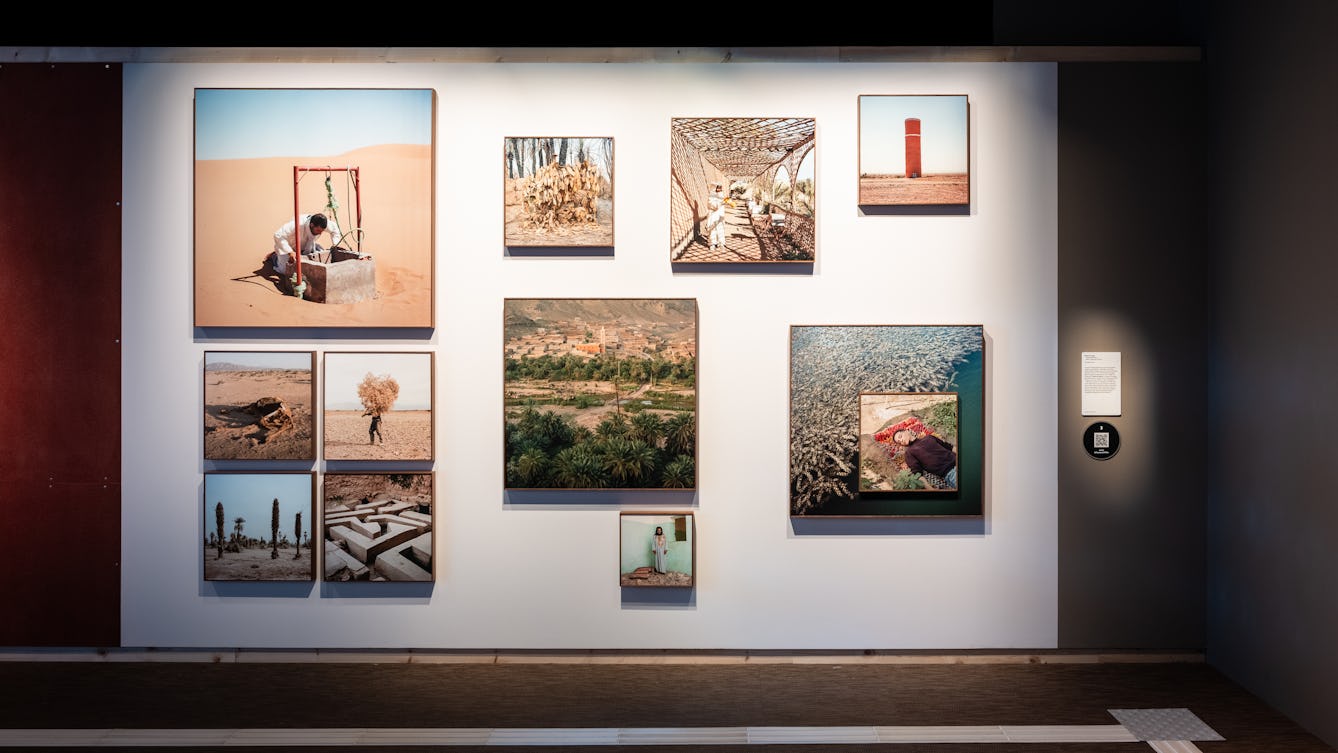When facing this work, there is a bench with light blue fabric directly to the right, where you can sit while listening to this track. The bench has a grey metal back and armrests.
My name is M’hammed Kilito, the creator of this work. On the section of wall to the left of the QR code are 12 coloured photographs of different sizes set at different heights. The largest photograph is a metre square and the smallest about 0.3 m. They show scenes of oases in Morocco and their inhabitants.
The photographs are a selection of works from my project ‘Before it’s gone’. I started this project over five years ago now, to better understand the realities of life for the inhabitants of Moroccan oases, and how their way of life is changing because of the dramatic effect of climate change and destructive human activities.
The largest image in the top left shows a man called Mustafa, a guide I was working with at the time. He is wearing a white gandoura, kneeling on a sand dune against a clear blue sky. He peers, looking down into a concrete well surmounted by a red metal frame, from which ropes dangle into the hole below.
There are many wells like this in the desert, and the nomads know them all by heart. They find them by navigating using the stars and the sun, to water themselves and their camels. I think it is a very striking image to express the scarcity of water in these environments.
The image in the centre of the arrangement shows a large town made up of sun-dried red-brick buildings, nestled in the foothills of an arid mountain, bordered by lush strips of date palms with a water course running between. This was an important image to include, because many people don't know much about what an oasis actually is. For me, the traditional oasis is the perfect model of a sustainability and a balanced ecosystem.
An oasis survives with just a little bit of water supported by a network of the underground qanat waterways. Date palms create a humid microclimate and retain water in soil. This creates an ecological defence against desertification and a refuge for biodiversity. The inhabitants of these environments had found an equilibrium between agricultural production and the water available.
The woman in the image on the top right works in apiculture (or beekeeping). She’s adjusting her bee-suit – a white cotton overall with trousers reaching to her trainers, and sleeves reaching to thick leather gloves. It has a zip-on hood with a black mesh that enables her to see out while keeping the bees at bay. Above her, a wickerwork trellis covers the entire balcony and casts a crosshatch of shade on the wall behind her.
Beekeeping is quite a longstanding vocation for a lot of women – a way to have economic freedom from their husbands in quite a patriarchal society. Through beekeeping they have the economic independence and freedom to do what they want and buy the things they want.
By talking to the inhabitants of the many oases I visited, I started witnessing that they had very severe droughts over the last seven years. The impacts of these droughts are highlighted in the four images towards the bottom left of the arrangement: dead date palms against the desert; dried-up waterways; the desiccated corpse of a camel.
We know that through official statistics from the Ministry of Agriculture, Morocco has lost two thirds of its oases during the last century. Now you have people that are coming from big cities in Morocco to create greenhouses and introduce agriculture that is not adapted to the ecosystem – we’re talking about watermelon, avocados and bananas. One watermelon needs between 1,000 to 1,500 litres of water, and these fruits or vegetables are not even for local consumption. They are all sent to Europe.
It is as if we’re taking water and exporting it outside the country. We’re still talking about colonialism, imperialism and capitalism and how it’s affecting this population and their oasis homes.
This is the end of Stop 3.
